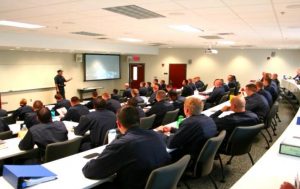By: Stuart J. Visnov, Chief Executive Officer, Echelon Protection & Surveillance
Word count: 551
 The basic security guard training and site-specific directives my company provides is tested and proven to work in almost any security environment to protect people and property. The exception to this rule are the security officers assigned to protect our education and religious institutions. While most security training is focused on “detect, deter, observe, and report” our institutional guards are taught to “be vigilant, think on their feet, make tactical decisions, and in case of crisis – save lives.”
The basic security guard training and site-specific directives my company provides is tested and proven to work in almost any security environment to protect people and property. The exception to this rule are the security officers assigned to protect our education and religious institutions. While most security training is focused on “detect, deter, observe, and report” our institutional guards are taught to “be vigilant, think on their feet, make tactical decisions, and in case of crisis – save lives.”
In addition to their basic security guard training, these officers receive additional high-level instruction in crisis response, stressing an “Active Safety” mentality, as opposed to an “Active Shooter” mentality. The end goal being the survival of themselves and the clients we secure and protect.
Knowing that most institutions now instruct their staff, students or congregants in the basics of RUN-HIDE-FIGHT or the A.L.I.C.E. (Alert, Lockdown, Inform, Counter, Evacuate) we train our school and institutional officers to understand these protocols and assist in their implementation.
These programs and many others, provide the end-user with extremely useful, rational, and practical information. However, they are based on the flawed belief that rational answers to irrational acts of violence are effective. Compounding the problem is the delivery of the training method. Although, it’s not ideal to just watch a video, listen to a power point and perform a few active shooter drills a year, these methods are far superior to no training at all. Our officers are familiar with a variety of basic active shooter training methods, so they’re better prepared in any event.
However, instructors who have had extensive training or law-enforcement experience know the sad truth is that the RUN-HIDE-FIGHT training method (no matter how professionally presented) cannot adequately address the chaotic, and unpredictable reality of an active shooter attack.
To be clear, we advocate RUNNING-ESCAPING as the most sensible option of all, but RUN-HIDE-FIGHT training encourages a mindset that better prepares people to save themselves and others during an active attack.
Among the problems in RUN-HIDE-FIGHT is the proven fact that this model is based on rational thought, linear thinking, fosters a non-aggressive/victim mindset, and fails to adequately deal with fear induced panic, fear, and freezing that human beings are prone to exhibit.
The linear thinking of RUN-HIDE-FIGHT has the psychological danger of falsely setting into clients’ minds that fighting should always be the last resort. This may waste precious time looking for a place to hide, when tactical circumstances dictate that physically confronting the attacker is the best response.
The bottom line is training people to realize that there is no one best answer and accept the reality that the best plans, locks, cameras, and alarms are no match for a determined attacker. Remember, that in every instance, the active shooter attack began long before the first shot was fired, and that the majority of the bloodshed occurs before the first law enforcement person can respond.
Our security instructors and curriculum planners spend hours teaching our guards the concepts of a survival mindset, the basics of tactical thinking, the valuable of each second, and the paralytic effects of fear and how it can be conquered. The most important message of all is that in times of crisis – we do not rise to the occasion, but rather fall back on our training.
…to be continued.


